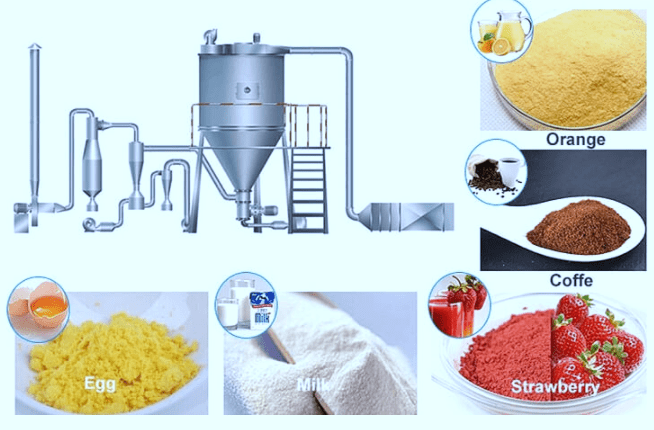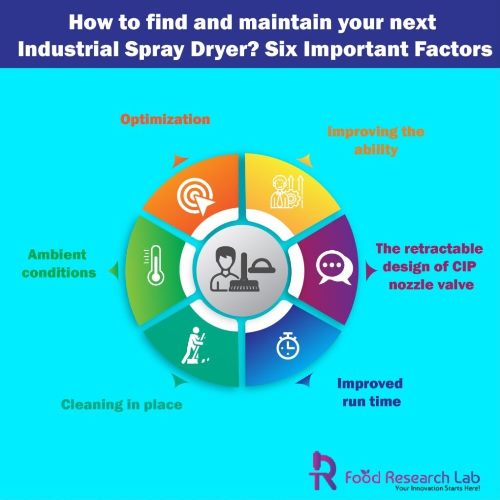We have seen the importance of spray dryer in encapsulation in our previous blog. The importance of spray drying is well received in the food industry and their demand is increasing proportionally. The food industry equipment market claims a growth of USD 450 Million during 2020-2024 progressing at a CAGR of 5% during this forecast period. As a manufacturer how would you choose your spray dryer which would suit your food type? As different type of dryer (e.g., pressure single-fluid nozzle atomizer, rotary wheel atomizer, pneumatic two-fluid nozzle atomizer) with drying stage (e.g., two stage spray dryer, multi-stage spray dryer, single -stage spray dryer) has distinct functions in food application (e.g., milk products, plant products fish and meat proteins, algae, β-carotene, chelates, cultures, emulsifiers, enzymes, fibers (e.g. inulin, fructooligosaccharides (FOS), Galactooliogosachharide, flavors and encapsulated flavors, gelatin, glucose, herb extract, non-dairy creamer, probiotics, proteins & protein hydrolysates, tomatoes, starch and maltodextrins, whole blood and haemoglobin, yeast and yeast extracts, fruit and vegetable products, carbohydrate product, others). For instance, extensively used to preserve fruit and vegetable juices in powder form, there are distinct varieties of dryers offering various features to complete the manufacturer’s needs as any improper usage would affect physiochemical and microstructural attributes of the product. (1)
How to find and maintain your next Industrial Spray Dryer? Six Important Factors
We have seen the importance of spray dryer in encapsulation in our previous blog. The importance of spray drying is well received in the food industry and their demand is increasing proportionally. The food industry equipment market claims a growth of USD 450 Million during 2020-2024 progressing at a CAGR of 5% during this forecast period. As a manufacturer how would you choose your spray dryer which would suit your food type? As different type of dryer (e.g., pressure single-fluid nozzle atomizer, rotary wheel atomizer, pneumatic two-fluid nozzle atomizer) with drying stage (e.g., two stage spray dryer, multi-stage spray dryer, single -stage spray dryer) has distinct functions in food application (e.g., milk products, plant products fish and meat proteins, algae, β-carotene, chelates, cultures, emulsifiers, enzymes, fibers (e.g. inulin, fructooligosaccharides (FOS), Galactooliogosachharide, flavors and encapsulated flavors, gelatin, glucose, herb extract, non-dairy creamer, probiotics, proteins & protein hydrolysates, tomatoes, starch and maltodextrins, whole blood and haemoglobin, yeast and yeast extracts, fruit and vegetable products, carbohydrate product, others). For instance, extensively used to preserve fruit and vegetable juices in powder form, there are distinct varieties of dryers offering various features to complete the manufacturer’s needs as any improper usage would affect physiochemical and microstructural attributes of the product. (1)

Figure 1 – Industrial spray drier and its applications (2)
The selection of a spray dryer needs to account for several factors. One of the important aspects to understand before investing in a spray dryer is the ease of use (if it is easy to regulate the particle size), setup and cleaning requirements. After the basics are accounted for, then the functional factor should be looked into. Equipment that is easy to operate, adjust and develop optimum conditions should be preferred. The main functions the instrument should allow you to control are:
- Control the airflow, temperature, and pump speed.
- The volume should equate to the pressure from an air compressor.
- The amount of Active Pharmaceutical Ingredient (API) required for development
- The strength and behaviour of the API
- The quantity of dry mix formulation required
- The overall batch size will be dictated by the solid content of the active and the amount of encapsulant.
- The solvent used for making up the emulsion will dictate the type of drying gas required, which could be either air or nitrogen.
Table 1 Common spray dryers used for different processes.
| Process Requirement | Spray Dryer of Choice |
| Multiple small batches (early feasibility studies) | Büchi B290 |
| Dry powders for nasal devices | ProCepT 4M8-TriX |
| Solvent drying | Büchi B290 |
| Solvent spray drying (clinical) | GEA Niro SD Micro |
| Potent APIs (non-GMP) | BüchiB290 ProCepT 4M8-TriX |
| PC control of process parameters and data | ProCepT 4M8-TriX |
| Larger scale – non-GMP batches | GEA Niro Mobile Minor |
| Clinical manufacture | ProCepT 4M8-TriX GEA Niro Mobile Minor |
Optimization
Optimization of the spray dryer is usually done in three ways. Firstly, it is done to maximize the production quality and yield. This can be achieved by modifying the inlet, outlet and feed temperature. Secondly, optimization is required to reduce losses in productivity, such as from Clean in Place (CIP). Thirdly, for seasonal fluctuations, spray dryers run better in winter as the amount of moisture in ambient air is higher. According to the Study published in Trends in Food Science & Technology, Response surface methodology was demonstrated as the most suitable tool for optimization of spray drying condition. (3)

Improving the ability
The capability of the spray dryer is measured by the amount of water it evaporates and is measured at the time of wet product at loading. The difference in inlet and outlet temperature needs to be raised for optimal evaporation. (4)
The retractable design of CIP nozzle valve
Although higher inlet temperatures result in better energy efficiency, they do not operate with extremely high inlet temperatures. As build-up can occur in spray dryer vessels at a certain outlet temperature. Moreover, the product should not become denatured, burned or deprived of nutrients or desired characteristics.
Improved run time
A good optimal production should have a well-scheduled operation and very limited or unplanned downtime. A feed system should be washed regularly that should be often switched between Products and batches. However, spray drying should be carefully monitored for allergens and cleaning between allergen production batches.
Recently, there are spray dryers with two feeds that operate at 100% capacity which works better for automized nozzle systems. Rotary or nozzle can be built to an atomizer and when one feed system is turned off, another nozzle can be utilized.
Cleaning in place
Planned cleaning definitely should be performed daily or between batches for the following reasons.
- To avoid fire or explosion caused by excessive build-up.
- The excessive build-up will also result in quality issue and cross-contamination.
- To avoid microbial growth in the chamber.
- To eliminate unnecessary maintenance issues.
Ambient conditions
Seasonal variation plays a major role in the spray dryer’s performance as explained earlier. Therefore, it is important to standardize the incoming air for optimal productivity year-round. The capacity of the dryer is limited by the overall moisture in the air while leaving the chamber. The air leaving the chamber should not be very moist for or while producing a stable product and might lead to a clumsy result. Moreover, to deliver at maximum efficacy the chamber should be operated at the total moisture content possible. As said in the introduction, parameters such as inlet and outlet temperature along with other parameters should be optimized for theoretical maximum productivity even during seasonal changes.
We can control this using a few components. Primarily, it is important to measure the ambient air moisture content with the help of a hygrometer and the air volume is measured. Spray dryer has fitted with a direct-fired gas burner that runs on natural gas or propane, moisture contribution can be accounted for up to 10%. In sum, the overall volume of water contribution which has evaporated should be measured. Using a flowmeter, the mechanical inefficiency and slippage should be accounted for improved accuracy. Finally, all the operational data must be collected to understand the machine, if it is operating at its optimum level and if the product yield is similar to the theoretical values. To make use of the best industrial spray dryer, food research lab guides you with food consulting services.

Let’s create something Innovative and Delicious together
Food Research Lab strives for excellence in new Food, Beverage and Nutraceutical Product Research and Development by offering cutting edge scientific analysis and expertise.




